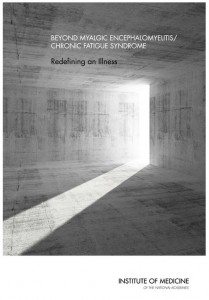 Today, the Institute of Medicine released its much anticipated report, “Beyond Myalgic Encephalomyelitis/Chronic Fatigue Syndrome; Redefining an Illness”.
Today, the Institute of Medicine released its much anticipated report, “Beyond Myalgic Encephalomyelitis/Chronic Fatigue Syndrome; Redefining an Illness”.
The report put forth four key recommendations:
- HHS should develop a toolkit appropriate for screening and diagnosing patients with ME/CFS in a wide array of clinical settings in which these patients are encountered…
– The committee put forth new diagnostic criteria that is far less complicated and more readily deployed in the clinical setting. A simpler criteria will lead to better, faster diagnosis. The new criteria is based on 4 of 5 core symptoms, requiring:
-
- A substantial reduction in activity
- More specifically: A substantial reduction or impairment in the ability to engage in pre-illness levels of occupational, educational, social, or personal activities, that persists for more than 6 months and is accompanied by fatigue, which is often profound, is of new or definite onset (not lifelong), is not the result of ongoing excessive exertion, and is not substantially alleviated by rest
- Post exertional malaise
- Unrefreshing sleep
- Either cognitive impairment or orthostatic intolerance
- A substantial reduction in activity
– These criteria build on existing ones, especially the Canadian Consensus Criteria (CCC), and also took into account the 10 years of research since the CCC was drafted.
- Physicians should diagnose ME/CFS if diagnostic criteria are met, following an appropriate history, physical examination, and medical work-up. A new code should be assigned to this disorder in the International Classification of Diseases, Tenth Edition (ICD-10) that is not linked to “chronic fatigue” or “neurasthenia” (emotional disturbance)…
– The committee clearly called for the removal of the exclusionary rule; existing criteria specify that if fibromyalgia, Lyme disease or a host of other known co-morbid conditions are diagnosed, then ME/CFS cannot be diagnosed. Comorbid diseases frequently occur and the committee stated that it is incumbent upon the physician to make the ME/CFS diagnosis as well.
– In the past, the exclusionary rule for ME/CFS diagnosis has slowed research progress. This new recommendation should improve research effectiveness and progress in the future.
- The disease be renamed “systemic exertion intolerance disease” (SEID), noting that the term “chronic fatigue syndrome” can result in stigmatization and trivialization and should no longer be used.
– The new name is intended to emphasize that this is a serious, complex systemic disease that frequently and dramatically impacts the lives of affected individuals
- Within 5 years, the diagnostic criteria set forth in this report should be re-examined when firm evidence supports modification to improve identification and care of patients
– The IOM realizes this is a learning process and there is much more to be done. It was explicitly stated that “we have made breathtakingly clear with HHS and others, the need for more research”
In the report the committee underscored the profound impact that ME/CFS has on the millions who suffer from it worldwide (est. 17 million) and the importance of getting people diagnosed. They estimate that more than 90% may not be diagnosed. ME/CFS costs the US economy between $17 to $24 billion annually in lost productivity and medical costs. Federal spending is woefully disproportionate (a mere $5 million annually) despite significant disease burden and costs. The goal of this report is to make ME/CFS – or SEID – more readily diagnosable and it issues a strong call for clinicians to take it seriously.
Already, in today’s Journal of the American Medical Association (JAMA), there is an important article about the new diagnostic criteria for ME/CFS, put forth in today’s IOM Report. JAMA is the most widely circulated medical journal in the world, with more than 325,000 print recipients and more than 14 million visits to the journal’s website annually.
The Solve ME/CFS Initiative thanks the volunteer members of the IOM committee, the sponsors of the project (HHS, AHRQ, CDC, FDA, NIH, and SSA), project participants and staff, and – most importantly – the patient community and advocates for their heroic efforts to ensure the best possible outcome. At first glance we are pleased with the committee’s recognition of the impact that ME/CFS has on the lives of millions, while recognizing there is still much to be done.
The Solve ME/CFS Initiative is committed to working with patients, researchers, federal agencies and experts in the field, to review the report’s recommendations and ensure appropriate next steps. We see this report as a critical step forward, providing the foundation for greater action to diagnose and treat patients and advance research. This opportunity must be seized. The patients, who for too long have received inadequate care and attention, deserve better.
Access the full IOM Report, Presentation and Diagnostic Algorithm HERE
http://www.nationalacademies.org/hmd/Reports/2015/ME-CFS.aspx

